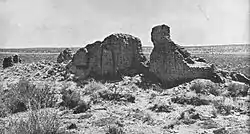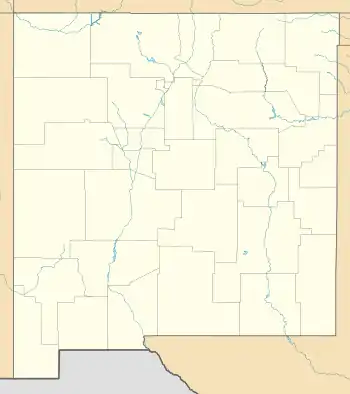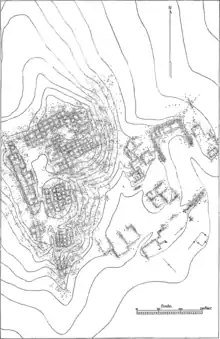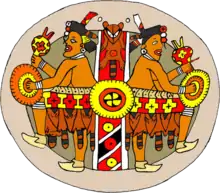Hawikuh Ruins
Hawikuh (Hawikku, "gum leaves" in Zuni[3]), was one of the largest of the Zuni pueblos at the time of the Spanish entrada. It was founded around 1400 AD.[3] It was the first pueblo to be visited and conquered by Spanish explorers. The pueblo site is located 12 miles (19 km) southwest of Zuni Pueblo, on the Zuni Indian Reservation in Cibola County, New Mexico. The site was designated a National Historic Landmark as the Hawikuh Ruins in 1960, and is included as part of the Zuni-Cibola Complex of archaeological sites, a larger National Historic Landmark District designated in 1974.
Hawikuh | |
 Ruins of Mission La Purísima Concepción de Hawikuh, photo circa 1886 | |
  | |
| Nearest city | Zuni, New Mexico |
|---|---|
| Coordinates | 34°55′56″N 108°59′4.4″W |
| Area | 10 acres (4.0 ha) |
| Built | 1539 |
| Part of | Zuni-Cibola Complex (ID74002267) |
| NRHP reference No. | 66000502[1] |
| Significant dates | |
| Added to NRHP | October 15, 1966 |
| Designated NHL | October 9, 1960[2] |
| Designated NHLDCP | December 2, 1974 |
History

Estevanico, an enslaved North African assigned to Fray Marcos de Niza's expedition, was the first non-native to visit Hawikuh, in 1539.
"Stephen reached Cibola [Hawikuh] loaded with the large quantity of turquoises they had given him, and some beautiful women whom the Indians who followed him and carried his things were taking with them and had given him. These had followed him from all the settlements he had passed, believing that under his protection they could traverse the whole world without any danger.
But as the people in this country were more intelligent than those who followed Stephen, they lodged him in a little hut they had outside their village, and the older men and the governors heard this story and took steps to find out the reason he had come to that country. For three days they made inquiries about him and held a council. The account which the negro gave them of two white men who were following him, sent by a great lord, who knew about the things in the sky, and how these were coming to instruct them in divine matters, made them think that he must be a spy or a guide from some nations who wished to come and conquer them, because it seemed to them unreasonable to say that the people were white in the country from which he came and that he was sent by them, being that he is black. Besides these other reasons, they thought it was hard of him to ask them for turquoises and women, and so they decided to kill him. They did this, but they did not kill any of those who went with him, although they kept some young fellows and let the other, about 60 persons, return freely to their own country. As these, who were badly scared, were returning in flight, they happened to come upon the friars in the desert 60 leagues from Cibola [Hawikuh], and told them the sad news, which frightened them so much that they would not even trust these folks who had been with the negro, but opened the packs they were carrying and gave away everything they had except the holy vestments for saying mass." [4]
He may have been killed when he unwittingly alarmed Zuni tribesmen with decorations that symbolized death, but it is just speculative.[3][5]
Francisco Vásquez de Coronado conquered the pueblo in 1540, hoping it was one of the legendary "Seven Cities of Gold". He recorded its native name at the time as Cevola, though others who accompanied him wrote it as Cíbola in their accounts. It has been conjectured that this name comes from a word meaning "buffalo". Coronado was severely disappointed by the lack of gold, but wrote that, "As far as I can tell, these Indians worship water, because it makes the corn grow and sustains their life." About the pueblo, he reported that,
Although they are not decorated with turquoises, nor made of lime or good bricks, nevertheless they are very good houses, with three, four, and five stories, where there are very good apartments ... and some very good rooms underground Kivas, paved, which are made for winter and have something like hot baths.[6]
Some Hawikuu residents fled to the Dowa Yalanne mesa top to escape the attackers of the Coronado expedition. The 14 structures at Dowa Yalanne used as a refuge from the Spaniards between 1540-1680 were called Heshoda Ayahltona ("ancient buildings above").[7]
In 1628 the Mission La Purísima Concepción de Hawikuh was established. The Spanish attempted to suppress the Zuni religion, and introduced the encomienda forced-labor system. In 1632, the Hawikuh Zunis rebelled, burnt the church, and killed the priest. In 1672, the church was burnt again, by Apache raiders, and it was burnt a final time in 1680 during the Great Pueblo Revolt, when all the Nuevo México pueblos rose against the Spanish. After this revolt, Hawikuh was permanently abandoned.[3]
The ruins of Hawikuh were excavated during the period 1917-23 by the Heye Foundation under the leadership of Frederick Webb Hodge. The records and artifacts from this excavation are now at the National Museum of the American Indian.[8] Hawikuh was declared a National Historic Landmark in 1961.[2][9]
Hawikuh is located on the Zuni Indian Reservation near Zuni, New Mexico.[9]
See also
References
- "National Register Information System". National Register of Historic Places. National Park Service. July 9, 2010.
- "National Historic Landmarks Survey, New Mexico" (PDF). National Park Service. Retrieved December 17, 2016.
- Lanmon, Dwight P. and Harlow, Francis, "A brief history of the Ashiwi (Zuni) pueblos", in The pottery of Zuni Pueblo, 2008, Museum of New Mexico Press. ISBN 0-89013-508-8
- Castañeda, Pedro, and George Parker. Winship. The Journey of Coronado. University Microfilms, 1966.
- Estevanico entry at the Handbook of Texas
- Coronado's letter of August 3, 1540, quoted at
- Flint, Richard and Shirley Cushing Flint "Dowa Yalanne, or Corn Mountain." Archived 2012-07-14 at Archive.today New Mexico Office of the State Historian. 21 April 2012.
- Hawikuh at National Park Service
- Marcia M. Greenlee (September 27, 1974). "National Register of Historic Places Inventory-Nomination: Site of Hawikuh Pueblo (Zuni Indian Tribe) one of legendary Seven Cities, discovered by Estevanico in 1539" (pdf). National Park Service. Cite journal requires
|journal=(help) and Accompanying 3 photos, from 1958 (32 KB)
External links
| Wikimedia Commons has media related to Hawikuh Ruins. |

